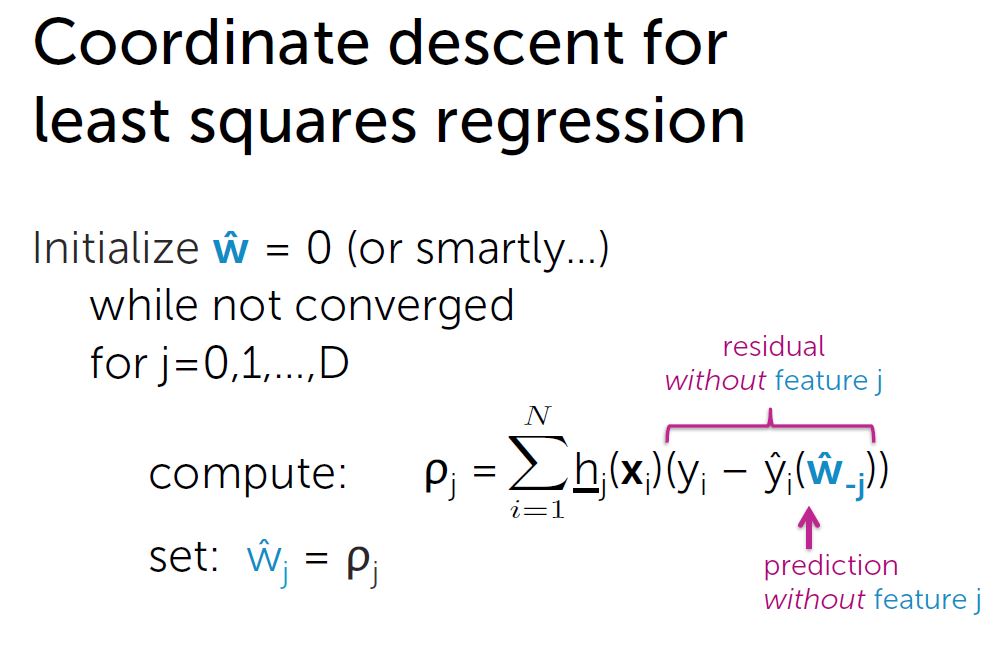笔记。
岭回归, 计算回归系数时使( RSS(w)+λ||w||2) 最小
岭回归的结果会是所有的特征的weight都较小,但大多数又不完全为零。
而实际情况中,有的特征的确与输出值相关程度很高,weight本就应该取一个较大的值,
而有的特征与输出结果几乎毫无关系,取一个很小的值不如直接取零。
岭回归的结果,一方面使“非常有用的”特征权值取不到一个较大的值,"有用"的特征无法很好表达,
另一方面又不能有效的筛掉“无用”的特征,很累赘。在特征很少时,这个缺陷可能没什么影响,但当
特征很多时,岭回归的缺陷较为明显。后续计算复杂度显著提高(很多非零的weight实际上很小)。
一个解决方法是在合理的范围里提高结果 (weights)的稀疏度(sparsity),尽量只留下“有用”的
特征的权值,其他相关度低的特征权值直接取零。这样后续计算只需要关注非零的权值,复杂度大大降低。
如何筛选出部分”有用“的特征?
一个方法是使用贪婪算法。
过程:
1. 特征集合F初始为空集;
2.用特征集合F拟合模型,得到weights, 计算training error;
3.选择下一个最佳特征 f:
使用{F+f}作为特征集合可以使training error达到新低;
4. F <-- F+ f
5.递归

Lasso 回归: minimize (RSS(w)+λ||w||1)
||w||1为L1 范数,系数绝对值之和 |w|
|w|导数?
直接解方程 或 梯度下降 方法都不适用。
可以用subgradient 方法。
Coordinate descent:
用于解决一类最小值问题。适用于 直接求全局最小值很困难, 但单个坐标求最小值很容易 的函数。
求解过程:

1. 初始化
2. 循环,单个坐标一个个更新到最小值
3. 计算每一步的步长(步长应越来越小),当最大步长 < ε 停止,否则循环


def lasso_coordinate_descent_step(i, feature_matrix, output, weights, l1_penalty):
# compute prediction
prediction = predict_output(feature_matrix, weights)
# compute ro[i] = SUM[ [feature_i]*(output - prediction + weight[i]*[feature_i]) ]
ro_i = np.dot(feature_matrix[:,i],(output - prediction + weights[i]*feature_matrix[:,i]))
if i == 0: # intercept -- do not regularize
new_weight_i = ro_i
elif ro_i < -l1_penalty/2.:
weight_i = ro_i + l1_penalty/2.
elif ro_i > l1_penalty/2.:
new_weight_i = ro_i - l1_penalty/2.
else:
new_weight_i = 0.
return new_weight_i
def lasso_cyclical_coordinate_descent(feature_matrix, output, weights, l1_penalty, tolerance):
converged = False
while converged == False:
coordinate = []
for i in xrange(len(weights)):
old_weights_i = weights[i] # remember old value of weight[i], as it will be overwritten
# the following line uses new values for weight[0], weight[1], ..., weight[i-1]
# and old values for weight[i], ..., weight[d-1]
weights[i] = lasso_coordinate_descent_step(i, feature_matrix, output, weights, l1_penalty)
# use old_weights_i to compute change in coordinate
coordinate.append(abs(weights[i] - old_weights_i))
if max(coordinate) < tolerance:
converged = True
return weights